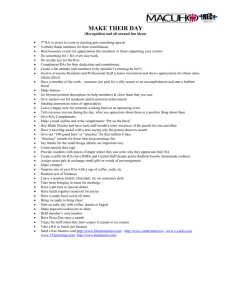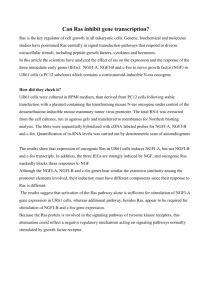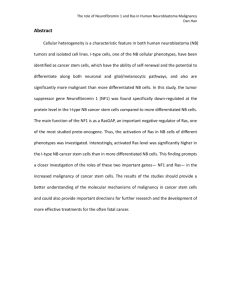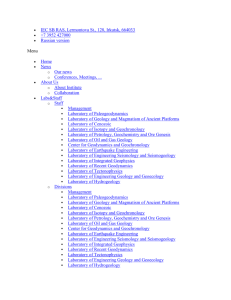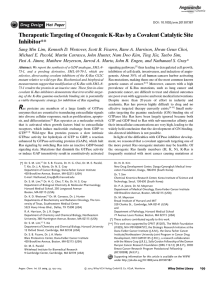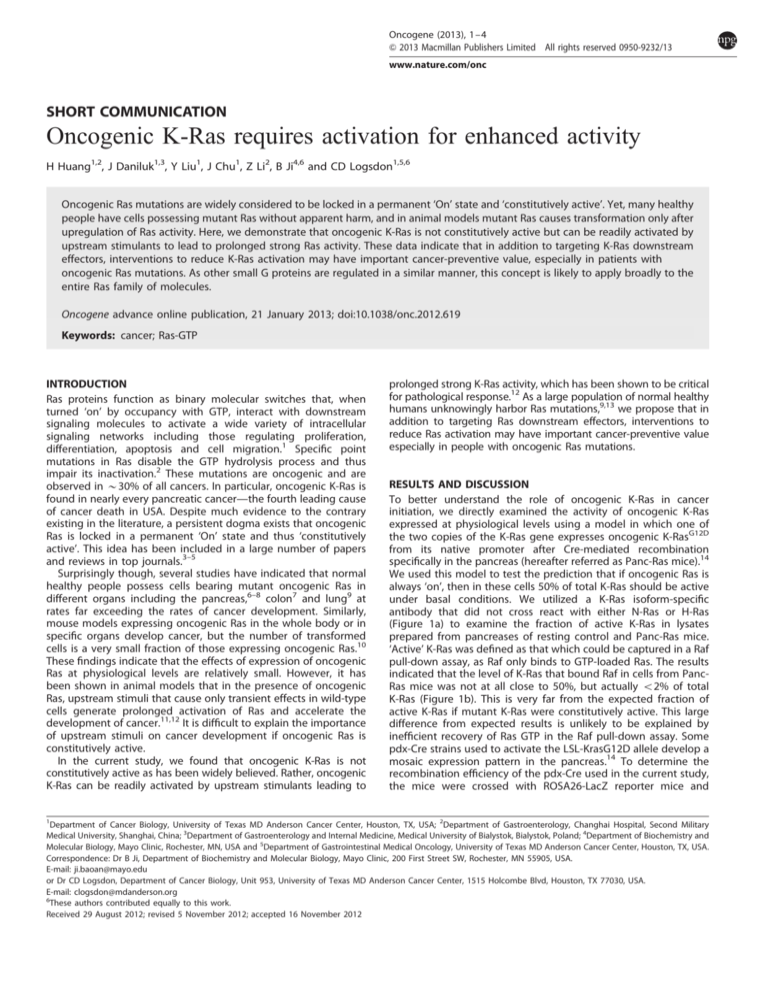
Oncogene (2013), 1–4
& 2013 Macmillan Publishers Limited All rights reserved 0950-9232/13
www.nature.com/onc
SHORT COMMUNICATION
Oncogenic K-Ras requires activation for enhanced activity
H Huang1,2, J Daniluk1,3, Y Liu1, J Chu1, Z Li2, B Ji4,6 and CD Logsdon1,5,6
Oncogenic Ras mutations are widely considered to be locked in a permanent ‘On’ state and ‘constitutively active’. Yet, many healthy
people have cells possessing mutant Ras without apparent harm, and in animal models mutant Ras causes transformation only after
upregulation of Ras activity. Here, we demonstrate that oncogenic K-Ras is not constitutively active but can be readily activated by
upstream stimulants to lead to prolonged strong Ras activity. These data indicate that in addition to targeting K-Ras downstream
effectors, interventions to reduce K-Ras activation may have important cancer-preventive value, especially in patients with
oncogenic Ras mutations. As other small G proteins are regulated in a similar manner, this concept is likely to apply broadly to the
entire Ras family of molecules.
Oncogene advance online publication, 21 January 2013; doi:10.1038/onc.2012.619
Keywords: cancer; Ras-GTP
INTRODUCTION
Ras proteins function as binary molecular switches that, when
turned ‘on’ by occupancy with GTP, interact with downstream
signaling molecules to activate a wide variety of intracellular
signaling networks including those regulating proliferation,
differentiation, apoptosis and cell migration.1 Specific point
mutations in Ras disable the GTP hydrolysis process and thus
impair its inactivation.2 These mutations are oncogenic and are
observed in B30% of all cancers. In particular, oncogenic K-Ras is
found in nearly every pancreatic cancer—the fourth leading cause
of cancer death in USA. Despite much evidence to the contrary
existing in the literature, a persistent dogma exists that oncogenic
Ras is locked in a permanent ‘On’ state and thus ‘constitutively
active’. This idea has been included in a large number of papers
and reviews in top journals.3–5
Surprisingly though, several studies have indicated that normal
healthy people possess cells bearing mutant oncogenic Ras in
different organs including the pancreas,6–8 colon7 and lung9 at
rates far exceeding the rates of cancer development. Similarly,
mouse models expressing oncogenic Ras in the whole body or in
specific organs develop cancer, but the number of transformed
cells is a very small fraction of those expressing oncogenic Ras.10
These findings indicate that the effects of expression of oncogenic
Ras at physiological levels are relatively small. However, it has
been shown in animal models that in the presence of oncogenic
Ras, upstream stimuli that cause only transient effects in wild-type
cells generate prolonged activation of Ras and accelerate the
development of cancer.11,12 It is difficult to explain the importance
of upstream stimuli on cancer development if oncogenic Ras is
constitutively active.
In the current study, we found that oncogenic K-Ras is not
constitutively active as has been widely believed. Rather, oncogenic
K-Ras can be readily activated by upstream stimulants leading to
prolonged strong K-Ras activity, which has been shown to be critical
for pathological response.12 As a large population of normal healthy
humans unknowingly harbor Ras mutations,9,13 we propose that in
addition to targeting Ras downstream effectors, interventions to
reduce Ras activation may have important cancer-preventive value
especially in people with oncogenic Ras mutations.
RESULTS AND DISCUSSION
To better understand the role of oncogenic K-Ras in cancer
initiation, we directly examined the activity of oncogenic K-Ras
expressed at physiological levels using a model in which one of
the two copies of the K-Ras gene expresses oncogenic K-RasG12D
from its native promoter after Cre-mediated recombination
specifically in the pancreas (hereafter referred as Panc-Ras mice).14
We used this model to test the prediction that if oncogenic Ras is
always ‘on’, then in these cells 50% of total K-Ras should be active
under basal conditions. We utilized a K-Ras isoform-specific
antibody that did not cross react with either N-Ras or H-Ras
(Figure 1a) to examine the fraction of active K-Ras in lysates
prepared from pancreases of resting control and Panc-Ras mice.
‘Active’ K-Ras was defined as that which could be captured in a Raf
pull-down assay, as Raf only binds to GTP-loaded Ras. The results
indicated that the level of K-Ras that bound Raf in cells from PancRas mice was not at all close to 50%, but actually o2% of total
K-Ras (Figure 1b). This is very far from the expected fraction of
active K-Ras if mutant K-Ras were constitutively active. This large
difference from expected results is unlikely to be explained by
inefficient recovery of Ras GTP in the Raf pull-down assay. Some
pdx-Cre strains used to activate the LSL-KrasG12D allele develop a
mosaic expression pattern in the pancreas.14 To determine the
recombination efficiency of the pdx-Cre used in the current study,
the mice were crossed with ROSA26-LacZ reporter mice and
1
Department of Cancer Biology, University of Texas MD Anderson Cancer Center, Houston, TX, USA; 2Department of Gastroenterology, Changhai Hospital, Second Military
Medical University, Shanghai, China; 3Department of Gastroenterology and Internal Medicine, Medical University of Bialystok, Bialystok, Poland; 4Department of Biochemistry and
Molecular Biology, Mayo Clinic, Rochester, MN, USA and 5Department of Gastrointestinal Medical Oncology, University of Texas MD Anderson Cancer Center, Houston, TX, USA.
Correspondence: Dr B Ji, Department of Biochemistry and Molecular Biology, Mayo Clinic, 200 First Street SW, Rochester, MN 55905, USA.
E-mail: ji.baoan@mayo.edu
or Dr CD Logsdon, Department of Cancer Biology, Unit 953, University of Texas MD Anderson Cancer Center, 1515 Holcombe Blvd, Houston, TX 77030, USA.
E-mail: clogsdon@mdanderson.org
6
These authors contributed equally to this work.
Received 29 August 2012; revised 5 November 2012; accepted 16 November 2012
Oncogenic Ras mutations
H Huang et al
2
Figure 1. Oncogenic Ras requires activation for enhanced activity. (a) Lysates from HEK293 cells transfected with K-, N- and H-Ras cDNA were
used to determine the specificity of corresponding antibodies by western blotting. (b) Active K-, N- and H-Ras were measured by a Raf pulldown assay from pancreas lysates of 2-month-old control and Panc-Ras mice (lanes a). For comparison with total corresponding Ras isoform
proteins, 5% of total lysates used for pull-down assay were loaded to adjacent wells (lanes t) and probed with isoform-specific antibodies.
Densitometry was performed using ImageJ software. (c) Active K-Ras was measured in isolated pancreatic acinar cells from control and PancRas mice after EGF (50 ng/ml) stimulation. (d) Oncogenic Ras is partially active in cancer cells. Active K-, N- and H-Ras (lanes a) were compared
with 10% of the corresponding Ras isoform levels used for pull-down assay (lanes t) in human pancreatic cancer cells (Bxpc3, Panc1 and
Mpanc96) and pancreatic cancer cells derived from Panc-Ras mouse (K8484). Note all cells except BxPC-3 possess oncogenic K-Ras mutations.
recombination efficiency was evaluated by X-gal staining. The
resulting animals showed that nearly 100% of cells underwent
recombination (Supplementary Figure 1). In addition, we also
crossed the LSL-KRasG12D mice with Ela-CreERT mice, which also
gave nearly 100% recombination in pancreatic acinar cells.15 The
same effects on Ras activity were observed in all of these models.
Another prediction made based on oncogenic Ras being ‘always
on’ would be that the maximal stimulation of K-Ras activity by
upstream activators would be p2-fold, as only the wild-type 50%
of K-Ras could be activated. To test this prediction, we treated
isolated pancreatic acinar cells prepared from control and resting
Panc-Ras mice with a Ras activator, epidermal growth factor (EGF).
We found that EGF stimulation increased the level of active K-Ras
by B10-fold compared with unstimulated cells (Figure 1c,
Supplementary Figure 2). Moreover, the difference between
theoretical and actual levels is quite large. Taken together, these
results are inconsistent with the hypothesis that oncogenic K-Ras
is ‘always on’. However, in the presence of oncogenic K-Ras EGF
stimulated prolonged elevation of Ras activity, which has been
shown to cause accelerated development of cancer.11,12 In
contrast, EGF caused only transient effects in cells with wild-type
K-Ras (Figure 1c). These data indicate that even though oncogenic
K-Ras is not constitutively active, it can be readily activated by
upstream stimulants.
Oncogene (2013), 1 – 4
To determine whether this observation were also true in
transformed cells, we compared the level of active K-Ras to that of
total K-Ras in lysates from human cancer cells and cancer cells
developed from tumors in Panc-Ras mice. Surprisingly, even in the
transformed cells active K-Ras was only B9% of total K-Ras
(Figure 1d). Ras signaling was also significantly upregulated by
EGF in these cells (Supplementary Figure 3). Similar results were
observed in human colon cancer cells (data not shown). Therefore,
in neither normal nor transformed cells did the percentage of
active K-Ras match that predicted if oncogenic K-Ras was
‘constitutively active.’
In summary, our results indicate that oncogenic K-Ras is not
constitutively active as has been widely believed. Rather,
oncogenic K-Ras can be readily activated by upstream stimulants.
However, as previously reported, once activated oncogenic K-Ras
has delayed kinetics of returning to the basal state and can
participate in a pathological feed-forward loop with inflammation.12 As other small G proteins are regulated in a similar manner,
this concept is likely to apply broadly to the entire Ras family of
molecules. On the basis of this new understanding, it could be
predicted that any stimulus that activates Ras or that promotes
the development of inflammation would facilitate the initiation of
cancer in cells bearing oncogenic Ras. This prediction has already
been upheld for a variety of stimuli including EGF, tumor growth
& 2013 Macmillan Publishers Limited
Oncogenic Ras mutations
H Huang et al
3
factor-a, CCK, PGE2 and lipopolysaccharide.12,16–18 These concepts
take on an increased clinical relevance when coupled with the
knowledge that there is a large population of normal healthy
humans that unknowingly harbor Ras mutations.9,13 A reasonable
conclusion would be that a reduction of factors that can activate
Ras signaling may have important cancer-preventive values in
patients with oncogenic Ras mutations (Figure 2).
MATERIALS AND METHODS
Genetically engineered mice
LSL-KRasG12D mice, which possess the conditional knock-in mutant
K-RasG12D, and pdx1-Cre mice were obtained from the Mouse Models for
Human Cancer Consortium Repository (Rockville, MD, USA).19 For targeted
expression of K-RasG12D in the pancreas, LSL-K-RasG12D mice were bred
with pdx1-Cre mice to generate LSL-K-RAS/pdx1-Cre double-transgenic
mice (Panc-Ras mice).
Acini preparation
Pancreatic acini were prepared as described previously20 with
modifications. Briefly, pancreata from mice were digested with purified
collagenase (100 unit/ml, Worthington Biochemicals, Lakewood, NJ, USA)
and incubated at 37 1C for 50 min with shaking at 120 r.p.m. Digested
tissue was than mechanically dispersed via pipette and passed through a
150-mm mesh nylon cloth. Acini were then purified three times with
gradient separation in Dulbecco’s modified Eagle’s medium (DMEM)
containing 4% bovine serum albumin. Purified acini were resuspended in
DMEM containing 0.1 mg/ml soybean trypsin inhibitor and 1% bovine
serum albumin for 1 h in a tissue culture incubator. After stimulation with
EGF 50 ng/ml (Sigma-Aldrich, St Louis, MO, USA) for different time periods,
acini were assayed for Ras activity.
recommended by the manufacturer (Millipore, Billerica, MA, USA).21 Briefly,
pancreatic samples were homogenized on ice in lysis buffer containing
25 mM 4-(2–hydroxyethyl)-1-piperazineethanesulfonic acid (pH 7.5), 1%
Igepal CA-630, 150 mM NaCl, 0.25% sodium deoxycholate, 10% glycerol,
25 mM NaF, 10 mM MgCl2, 1 mM ethylenediaminetetraacetic acid, 10 mg/ml
aprotinin, 10 mg/ml leupeptin and 1 mM sodium orthovanadate. These
samples were sonicated and centrifuged at 15 000 g for 10 min at 4 1C to
remove cellular debris. Aliquots of lysates were set aside to allow
quantification of total Ras and protein concentrations. Equal amounts of
lysate were incubated for 30 min at 4 1C with agarose beads coated with
Raf-Ras binding domain. The beads were then washed three times with
ice-cold lysis buffer, boiled for 5 min at 95 1C, and active Ras was analyzed
by immunoblotting following standard western blot analysis protocols
using K-, N- and H-Ras-specific antibodies. For comparison with total
corresponding Ras protein, 5–10% of total lysates used for pulldown were
loaded to adjacent wells.
Western blot analysis
Cell or tissue lysates were prepared, separated by sodium dodecyl sulfate/
polyacrylamide gel electrophoresis, and transferred to nitrocellulose
membranes. The membranes were blocked for 1 h at room temperature
with 3% nonfat milk in Tris-buffered saline containing 0.05% Tween 20 and
incubated overnight at 4 1C with one of the following primary antibodies:
K-Ras (Santa Cruz sc-30, Santa Cruz, CA, USA); H-Ras (Santa Cruz sc-520)
and N-Ras (Santa Cruz sc-519) (1:200; Santa Cruz), GAPDH (1:10000; SigmaAldrich), phospho-Erk and total Erk (1:1000; Cell Signaling Technology,
Danvers, MA, USA). Immunodetection was performed with the corresponding Alexa Fluor 680-conjugated secondary antibodies to allow detection
with the Odyssey Infrared Imaging System (LI-COR Biosciences, Lincoln, NE,
USA). All images were converted to grayscale. Densitometry was measured
using ImageJ software (http://rsbweb.nih.gov/ij/).
Study approval
Ras activity assay
Ras activity refers to the level of guanosine triphosphate-bound Ras, which
is able to bind Raf as measured using a Raf pull-down assay kit as
All animal experiments were approved by The University of Texas MD
Anderson Cancer Center’s Institutional Animal Care and Use Committee.
CONFLICT OF INTEREST
The authors declare no conflict of interest.
ACKNOWLEDGEMENTS
We thank Dr David Tuveson (UK Cambridge Research Institute) for providing the
mouse pancreatic cancer cell line K8484. This work was supported by NIH DK052067,
CA016672, P20 CA101936, CA155165, P50 CA102701 and the Lockton Endowment.
The work was supported in part by grant 30910103911 (to Z Li) from the National
Natural Science Foundation of China.
REFERENCES
Figure 2. Targeting both upstream and downstream of Ras signaling
for cancer prevention. Multiple factors are able to act as Ras
activators through interactions with upstream receptors (e.g., EGF
receptor). The effect on wild-type Ras is a transient elevation of
downsteam signaling pathways including those regulated by
RALGDS, RAF1 and PI3K (not shown). However, when oncogenic
Ras is present, the downstream signaling after stimulation is
prolonged at a high level. Elevated Ras activity generates
inflammatory mediators that further activate Ras, and thus sustain
Ras activity at high levels through a feed-forward loop. Previously
emphasis has been focused on targeting downstream pathways
activated by Ras, as oncogenic Ras was considered to be
constitutively active. However, endogenous expression of mutant
Ras gives rise only low level of Ras activity, which does not cause
pathological effects unless Ras activity is upregulated. On the basis
of the evidence that oncogenic Ras is not active without input from
upstream activators, we propose that targeting the upstream
mechanisms of Ras activation would be an alternative approach
for cancer prevention, especially in patients with Ras mutations.
& 2013 Macmillan Publishers Limited
1 Spaargaren M, Bischoff JR, McCormick F. Signal transduction by Ras-like GTPases:
a potential target for anticancer drugs. Gene Expr 1995; 4: 345–356.
2 Scheffzek K, Ahmadian MR, Kabsch W, Wiesmuller L, Lautwein A, Schmitz F et al.
The Ras-RasGAP complex: structural basis for GTPase activation and its loss in
oncogenic Ras mutants. Science 1997; 277: 333–338.
3 Koeffler HP, McCormick F, Denny C. Molecular mechanisms of cancer. West J Med
1991; 155: 505–514.
4 Pylayeva-Gupta Y, Grabocka E, Bar-Sagi D. RAS oncogenes: weaving a tumorigenic
web. Nat Rev Cancer 2011; 11: 761–774.
5 Karnoub AE, Weinberg RA. Ras oncogenes: split personalities. Nat Rev Mol Cell Biol
2008; 9: 517–531.
6 Yan L, McFaul C, Howes N, Leslie J, Lancaster G, Wong T et al. Molecular analysis to
detect pancreatic ductal adenocarcinoma in high-risk groups. Gastroenterology
2005; 128: 2124–2130.
7 Lu X, Xu T, Qian J, Wen X, Wu D. Detecting K-ras and p53 gene mutation from
stool and pancreatic juice for diagnosis of early pancreatic cancer. Chin Med J
2002; 115: 1632–1636.
8 Parsons BL, Meng F. K-RAS mutation in the screening, prognosis and treatment of
cancer. Biomark Med 2009; 3: 757–769.
9 Yakubovskaya MS, Spiegelman V, Luo FC, Malaev S, Salnev A, Zborovskaya I et al.
High frequency of K-ras mutations in normal appearing lung tissues and sputum
of patients with lung cancer. Int J Cancer 1995; 63: 810–814.
Oncogene (2013), 1 – 4
Oncogenic Ras mutations
H Huang et al
4
10 Guerra C, Mijimolle N, Dhawahir A, Dubus P, Barradas M, Serrano M et al. Tumor
induction by an endogenous K-ras oncogene is highly dependent on cellular
context. Cancer cell 2003; 4: 111–120.
11 Carriere C, Young AL, Gunn JR, Longnecker DS, Korc M. Acute pancreatitis
markedly accelerates pancreatic cancer progression in mice expressing oncogenic
Kras. Biochem Biophys Res Commun 2009; 382: 561–565.
12 Daniluk J, Liu Y, Deng D, Chu J, Huang H, Gaiser S et al. An NF-kappaB pathwaymediated positive feedback loop amplifies Ras activity to pathological levels in
mice. J Clin Invest 2012; 122: 1519–1528.
13 Tada M, Ohashi M, Shiratori Y, Okudaira T, Komatsu Y, Kawabe T et al. Analysis
of K-ras gene mutation in hyperplastic duct cells of the pancreas without
pancreatic disease. Gastroenterology (Research Support, Non-U.S. Gov’t) 1996;
110: 227–231.
14 Hingorani SR, Petricoin EF, Maitra A, Rajapakse V, King C, Jacobetz MA et al.
Preinvasive and invasive ductal pancreatic cancer and its early detection in the
mouse. Cancer cell 2003; 4: 437–450.
15 Ji B, Song J, Tsou L, Bi Y, Gaiser S, Mortensen R et al. Robust acinar cell transgene
expression of CreErT via BAC recombineering. Genesis 2008; 46: 390–395.
16 Ardito CM, Gruner BM, Takeuchi KK, Lubeseder-Martellato C, Teichmann N, Mazur
PK et al. EGF Receptor Is Required for KRAS-Induced Pancreatic Tumorigenesis.
Cancer cell 2012; 22: 304–317.
17 Siveke JT, Einwachter H, Sipos B, Lubeseder-Martellato C, Kloppel G,
Schmid RM. Concomitant pancreatic activation of Kras(G12D) and Tgfa results
in cystic papillary neoplasms reminiscent of human IPMN. Cancer cell 2007; 12:
266–279.
18 Guerra C, Schuhmacher AJ, Canamero M, Grippo PJ, Verdaguer L, Perez-Gallego L
et al. Chronic pancreatitis is essential for induction of pancreatic ductal adenocarcinoma by K-Ras oncogenes in adult mice. Cancer cell 2007; 11: 291–302.
19 Jackson EL, Willis N, Mercer K, Bronson RT, Crowley D, Montoya R et al. Analysis of
lung tumor initiation and progression using conditional expression of oncogenic
K-ras. Genes Dev 2001; 15: 3243–3248.
20 Williams JA, Korc M, Dormer RL. Action of secretagogues on a new preparation
of functionally intact, isolated pancreatic acini. Am J Physiol 1978; 235:
517–524.
21 de Rooij J, Bos JL. Minimal Ras-binding domain of Raf1 can be used as an activation-specific probe for Ras. Oncogene 1997; 14: 623–625.
Supplementary Information accompanies the paper on the Oncogene website (http://www.nature.com/onc)
Oncogene (2013), 1 – 4
& 2013 Macmillan Publishers Limited

